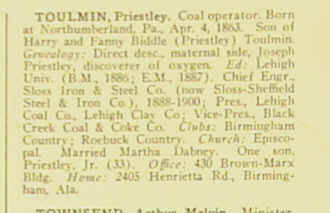Lehigh Mines
The Birmingham Public Library's Linn-Henley Research Library contains the Archives. Although Linn-Henley is open on the weekend, the archives are only open during the week. If you can go, and are interested in history then this is the place to find things. Great fun and helpful staff.
The Toulmin Papers contained several maps pertinent to the Lehigh and other related ventures in the area. In addition, the Record Book of the Corporation as well as personal papers and letters regarding the Lehigh Company were found. It is quite likely that Mr. Toulmin named these mines in honor of his alma mater, Lehigh University in Pennsylvania, where he graduated in Engineering in 1886 and 1887. This is noted in Who's Who in the South, 1927
It turns out that the Lehigh Coal Company was founded in 1901 and was active at least into the 1920's under that name. Additional research could likely determine more details. I was certainly interested in seeing if there was anything about the 36" narrow gauge railroad where Brian's locomotive worked.
This
map shows that there was indeed a narrow gauge railroad at Lehigh. A
detailed look shows more.
This map shows the "dinky" line, and indicates that it extends to a mine location about a mile away. It is assumed that the line ran to the mine tunnel entrance. The track configuration shows a "wye" track so that the locomotive could be turned. It also indicates that in 1922, there had been a Fordson Locomotive at Lehigh, one might assume the "old" dinky house would have at one time been home to a narrow gauge steam locomotive.
In this detailed view we see that there as a tipple where the dinky would unload so that coal could be loaded onto the cars on the L&N spur to Village Springs, located on the Birmingham Mineral's Branch line back toward Birmingham.
It is also noted that there is a rock crusher at this site, and a review of materials in the Archives indicates that this was owned by a separate but likely related clay mining operation, which apparently used the same dinky line to get its material to the rail spur.
Finally one may see that there was a depot building at Lehigh, and that there was the ever present commissary where the mine community could shop for supplies, likely using company issued "scrip" for currency.
Another necessary building in the mine camp was the "smithy" or blacksmith shop. This would have served as the machine repair shop as well as to take care of the needs of shoeing horses or mules in the camp. There is an "old" stable building shown which may indicate that the dinky line replaced mules from an earlier time at Lehigh. Although, it seems unlikely that the Whitcomb would have gone underground.
Another item of interest on this old map is the notation that the spur extends to the left to an "Old Mine". Based on the layout of the spur on the USGS map, it is presumed that the original spur may have gone to a mine entrance and this notation seems to confirm this idea. It was common for multiple mine openings to be started in sequence with the earlier openings being abandoned from various reasons, such as problems with flooding or simply being worked out.
Apparently Lehigh was a "going concern" as seen on the next page.